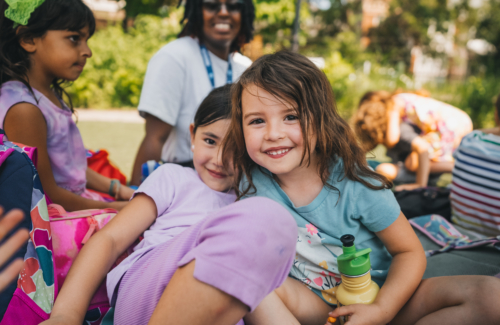4 Engaging STEM Activities for Kindergarten

By the time young minds reach a kindergarten classroom, they are already learning the basics of scientific observation; like how to identify patterns and several other essential Science, Technology, Engineering and Mathematics (STEM) concepts. But children’s STEM exploration doesn’t need to end when the school bell rings.
From capturing a cloud in a jar to building a balloon-powered car, this guide highlights four fun, informative and relatively simple STEM activities you can enjoy with your little ones. Whether you’re a teacher to many or a parent to one, try out these projects to entertain, educate and explore with your kids.
#1 Cloud in a Jar
Every day, water from lakes, oceans and other sources evaporates into the air, and condenses into clouds above our heads. But on this grand of a scale, it’s difficult to actually see the process of cloud formation in action.
However, when we break things down to a more manageable, miniature level, we can see the forces of evaporation and condensation first-hand.
To capture your cloud in a jar, you’ll need:
- A mason jar and lid
- Hot water
- Ice
- Hairspray
To create the condensation:
- Fill one-third of the jar with hot (but not boiling) water and swish it around to warm the sides.
- Place the lid upside-down atop the jar.
- Fill the lid with ice cubes.
- Quickly remove the lid, spray in a bit of hairspray and replace it atop the jar.
- Watch in amazement as a cloud forms before your very eyes!
- Once the jar is thick with condensation, release the cloud by removing the lid.
Clouds form when warm, moist air (such as that in the jar after the addition of hot water) meets a cooling force (such as the ice cubes). Before clouds can come together, however, they need a small, solid particle to collect around. In nature, this is usually a speck of dust but, in this experiment, the hairspray does the same job.
The Cloud in a Jar experiment gives kids a first-hand glimpse into the natural process of condensation. This experiment is also an interactive way to introduce them to the concept of the water cycle, and explain how every drop we drink, cook with and bathe in will become a cloud someday.
#2 DIY Invisible Ink
Throughout time, people have sent hidden messages to share information and avoid detection. Before email and texting made secret communication easier, messengers carried letters written in invisible ink!
Invisible ink was first discovered over 2,500 years ago when lemon juice was used to pen important, secret documents. The same method still works wonderfully to this day—so the only materials you’ll need for this project are:
- Lemon juice
- A bowl
- A thin-tipped paintbrush
- A sheet of paper
- An iron and ironing board
To write your secret letter:
- Squeeze some lemon juice into your bowl.
- Gently dip your paintbrush in the lemon juice, shake off the excess and begin writing your letter.
- Keep writing until you finish your note, getting more lemon juice from the bowl when necessary.
- Allow the paper to sit flat and dry completely (about 20 minutes).
After your note is fully written and dried, a little heat is all you need to reveal the hidden message. To uncover the secrets of your invisible ink:
- Heat your iron to the high setting and lay your paper on the ironing board.
- Iron the sheet for about 15 to 30 seconds—or until the words begin to appear.
- Allow your paper to cool for a minute before picking it up and reading your hidden message.
Making invisible ink allows your kids to relive a technological discovery that made a huge impact on the history of our world. They’ll have a ton of fun writing hidden messages and decoding them with their friends, as well. Just be sure any use of the iron occurs under strict adult supervision!
#3 Elephant Toothpaste
This exhilarating experiment teaches kids the basics of chemical reactions. And, no—you won’t have to get any pachyderms involved. Instead, you’ll combine a small amount of material to make a final product that’s much larger than the sum of its parts.
To get started, gather up:
- An empty plastic bottle
- Dry baker’s yeast
- Warm water
- Liquid dish soap
- Hydrogen peroxide (3% works best)
- Measuring cups and spoons
- Liquid food coloring (optional, but very cool)
NOTE: Making elephant toothpaste can get pretty messy; be sure to wear safety glasses and experiment outdoors or in the shower to simplify cleanup.
To begin the process:
- Measure out a one-half cup of hydrogen peroxide and pour it into your bottle.
- Squeeze in a large squirt of dish soap and swirl gently to mix it together.
- If you’re planning to add food coloring, put a few drops in now. If you want a solid color, put it directly into the peroxide and soap. If you want stripes, squeeze it inside the lip of the bottle and let it sit there.
- Stir together one tablespoon of yeast with three tablespoons of warm water for about 30 seconds.
- Pour the yeast and water mixture into your bottle, step back and watch your elephant toothpaste sprout to life right in front of your eyes!
The bottle will foam up and overflow quickly—similar to classic baking soda and vinegar volcano experiments. Explain to kids that what they just witnessed was a chemical reaction, and that mixing different substances produce different results. The bubbles in elephant toothpaste are from gas being created and escaping through the top of the bottle, and the foam is formed when this gas becomes caught in the soap.
If your kids simply can’t get enough of this playful project, try creating elephant toothpaste in different containers with different shades of food coloring and without soap. Ask your children to point out the differences in each experiment and guess why the results varied as you changed certain components.
#4 Balloon-Powered Cars
This fast-paced project teaches kids basic physics principles, such as force and acceleration. The Balloon-Powered Cars project will help them become comfortable with combining different parts to create a functional machine (i.e. the essence of engineering). Likewise, it’s an effective way to introduce them to the idea of upcycling old trash into something useful. On top of all that, it’s just plain fun and will keep them entertained for hours.
To get your balloon-powered car motoring, you’ll need:
- A plastic bottle
- Four plastic bottle caps of equal size
- A wooden skewer
- Two straws
- Tape
- A balloon
- Scissors
After assembling all your items, lay them out on a sturdy work surface and:
- Cut one of the straws in half and tape both pieces horizontally across one side of the bottle.
- Snap or cut your skewer in two and place one piece through each of the straw halves.
- Cut small holes in the top of each bottle cap in the shape of an addition sign (+).
- Slide one cap onto each end of the skewers. Put your car on the ground and give it a little push. If it rolls easily, move on to the next step; if not, readjust until it does.
- Slide the balloon over one end of the other straw and tape it in place with an airtight seal.
- Cut a hole near the top of the bottle that’s just large enough for the straw to slide through.
- Push the free end of the straw through the new hole and out the mouth of the bottle before securing it with tape.
- Blow into the straw, inflate the balloon, set your car on the ground and let it go!
Your balloon-powered car should whiz across the floor,propelled by the force of air pushing out of the balloon in the opposite direction of the car’s movement. Because the air is coming out of a singular, controlled spot, the car moves forward instead of bouncing around the room like a balloon would on its own.
If you have multiple children doing this experiment, have them race each other for added fun. Show them how the car goes faster when the balloon is fully inflated (more force is used) and slower when it’s smaller (less force is used). Finally, explain how engineers and scientists are constantly trying to find cool new uses for waste materials, and balloon-powered cars are just one use for bottles, straws and other recyclables.
Introduce Your Children to More STEM Concepts at Camp Galileo
Creating engaging, fun projects such as these is a brilliant way to introduce your child to essential STEM concepts—but they’re just the tip of the iceberg in comparison to a summer of exploration and discovery at Camp Galileo. Kindergartners can enjoy a variety of STEM-based activities at Camp Galileo, including building model rockets, functional model trains and custom theme parks!
Camp Galileo’s one-of-a-kind program delves into the world of STEAM (Science, Technology, Engineering, Art and Mathematics) through collaborative, play-based projects that inspire kids to improve the world around them. Confidence, resilience and critical thinking are the core tenets we instill in campers as we play through a summer schedule that elevates traditional camp into a truly unforgettable experience.
From kindergarten to 8th grade, Camp Galileo provides kids with hands-on, educator-led STEAM activities, outdoor adventures and more. We also provide a Counselor In Training program for 8th-10th graders at select locations. We have more than 70 camps across the country, so there’s likely one near you! Enroll your child today to ensure an engaging, enriching experience this summer.
Sources:
- Finio Ben, Science Buddies. “Build a Balloon-Powered Car”. Scientific American. 18 May 2017. https://www.scientificamerican.com/.
- Finio Ben, Science Buddies. “Make Elephant Toothpaste”. Scientific American. 1 August 2019 https://www.scientificamerican.com/.
- National Association for the Education of Young Children. “What do Children Learn in a High-Quality Kindergarten Program?”. NAEYC https://www.naeyc.org/our-work/families/what-do-children-learn-kindergarten-program.
- Science Museum Oklahoma. “Try This: Make a Cloud in a Jar”. 3 April 2020. https://www.sciencemuseumok.org/.
- The National Archives UK. “How to make invisible ink”. 8 March 2021. https://www.nationalarchives.gov.uk/.
- The National Archives UK. “Invisible ink recipe”. 8 March 2021 https://www.nationalarchives.gov.uk/.

